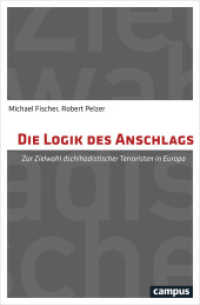- ホーム
- > 洋書
- > ドイツ書
- > Mathematics, Sciences & Technology
- > Earth Science
- > geography
Full Description
This edited volume offers innovative research and applications in the analysis, modelling, and mapping of crime using geospatial and GeoAI technologies. This is a follow-up publication of an edited volume by the same editor with a similar title, Crime Modeling and Mapping Using Geospatial Technologies, published by Springer in its popular Geotechnologies and the Environment series in 2013.
The book comprises sixteen chapters authored by some of the most esteemed researchers in the field. These chapters are organized into four sections: big data and microspaces (Part I), mobility (Part II), drugs (Part III), and additional geospatial applications (Part IV).
Part I includes five chapters focusing on interactive crime mapping by using large data sets obtained from social media and analyzing these data using AI applications; a fundamental spatial problem that considers spatial properties of a crime dataset to determine an adequate areal unit size; different aspects of the influence or prediction of crime in microspaces; and the use of sampled surface pollen to model the search space for documented forensic cases. Part II has four chapters that introduce two route generation heuristics that automate the creation of hot spots policing patrol routes; discuss how to optimize police response with two different maximal covering location problems; and examine how human mobility patterns impact crime trends and modelling. Part III consists of three chapters addressing opioid overdose patterns using a spatial mixed methods approach; spatial-temporal changes in hot spots of drug-related offences; and how geospatial technology can be used to empower stakeholders to make informed policy decisions about alcohol-related motor vehicle collisions. Part IV comprises four diverse chapters that do not fit under a single theme. The topics discussed include: the impact of video surveillance on the spatial distribution of crime; the identification of the location of missing persons outreach events with spatial clustering analysis methods; an examination of the distribution patterns of all types of juvenile delinquency to investigate underlying factors; and a review and comparison of GeoAI methods for detecting and mapping illegal logging.
This book would be useful to faculty, students and research scholars from geography, sociology, criminal justice, criminology, forensic sciences, and other related disciplines as well as to crime analysts working for law enforcement agencies at the local, state, or federal levels from around the world.
Contents
Part I. Big Data and Micro Spaces.- 1. Big Data and Social Media Analytics Opportunities for Interactive Crime Mapping (Yunus Serhat Bicakci , Alina Ristea , and Kate Bowers).- 2. Finding an Adequate Areal Unit to Map Crime: a Spatial Data Perspective (Rafael G. Ramos).- 3. Investigating the Influence of Residents and Nonresidents on Crime at Micro Space-time Intervals (Elizabeth R. Groff, Cory P. Haberman and Mary Jo Fraley).- 4. Geoforensic Search Space Modeling: Applications to Documented Cases (Haoyu Wang, Jennifer A. Miller).- 5. Predicting Crime at Micro Places: Comparing Machine Learning Methods Across European Cities (Robin Khalfa, Thom Snaphaan, Alina Ristea, Ourania Kounadi and Wim Hardyns).- Part 2. Mobility.- 6. Route Generation Heuristics for the Automated Creation of Hot Spots Policing Patrol Routes (Francisco Carlos F. Nunes Juniora, Jhonata A. S. Matiasa, Spencer P.).- 7. Optimizing Police Response with the Multiple-Type Demand & Multiple-Type Facility Maximal Covering Location Problems (Ashleigh N. Price and Kevin M. Curtin ).- 8. Direction-Specific Human Mobility Improves Crime Modeling: Evidence from Houston (Ling Wu, Qian He, Chunwu Zhu, Xiao Huang, Xinyue Ye).- 9. Using Mobility Data based on GPS Locations for the Analysis of Urban Crime - a Test of Geofencing for Filtering Transit Mobility (Dietrich Oberwittler, Christopher Gahler, Carina Hasitzka).- Part 3. Drugs.- 10. Using Spatial Mixed Methods to Reveal the Geographic Nuances of Opioid Overdose Patterns in Small and Rural Towns (Andrew Curtis, Jacqueline Curtis, Jayakrishnan Ajayakumar, and Eric Jefferis).- 11. Analysis of Spatial and Temporal Changes in Hot Spots of Drug-related Offenses in Vienna, Austria between 2010 and 2019 (Carina Hasitzka, Michael Leitner).- 12. Using GIS and Web Maps for Community Engagement on Alcohol-Related Crashes and Policy Reform (Aimee Moles, Andrew Burns, Austin Matthews & Ashley Tillison).- Part 4. Additional Geospatial Applications.- 13. The Impact of Video Surveillance on the Spatial Distribution of Crime - a Case Study from Krakow, Poland (Andrzej Leśniak, Agnieszka Polończyk-Sudoł and Przemysław Waśniowski).- 14. A Spatial Clustering Analysis of Missing Persons Data to Generate Spatially Informed Community Outreach Event Locations (Liam J. Johnson, Ginesse A. Listi, Teresa, V. Wilson, and Michael Leitner).- 15. Unraveling the County-Level Spatial Patterns of Juvenile Delinquency and its Underlying Determinants in Texas (Ling Wu , Cuiling Liu , Michael Lemke , Xinyue Ye ).- 16. Mapping Illegal Logging using GeoAI (Valeria Martin, John D. Morgan & K. Brent Venable).








